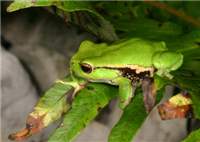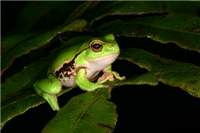Family
HylidaeGenus
LitoriaSpecies
nudidigita/nudidigitus
Threats/Control Methods - Regional
Introduced fish species such as Trout,Salmo trutta andOnchorhychus mykiss are thought to be linked to localised population declines. It has also been thought that Chytrid fungus may also pose a threat to the species.
For more information on the Chytrid fungus © Link to fact sheet http://www.deh.gov.au/biodiversity/invasive/publications/c-disease/
To prevent the spread of the Chytrid fungus it is important to wash your shoes before entering and after leaving frog habitats.
Frogs drink and breathe through their skin and are very sensitive to chemicals in their environment. Where possible, you should not handle frogs, as the natural bacteria on your hands or chemicals such as sunscreen can damage their skin and cause illness or death.
Local/Urban Actions
No actions directly aimed at the species are currently underway. However broadscale frog monitoring occurs annually within the ACT. The Frogwatch program provides training for community volunteers each October, with monitoring then being undertaken by volunteers over a two week period.For more information on Frogwatch contact:The ACT Frogwatch Coordinator, Ginninderra Catchment Group; Ph(02)62783309 or email: [email protected]Although it is unlikely that this species will be attracted, it is possible to attract other frog species to urban backyards through simple landscaping techniques. The Australian National University and the Ginninderra Catchment Group have developed a guideline to help you encourage frogs into your backyard called [Link - Creating a Frog Friendly Habitat in the ACT Community]
Distinguishing Features
A small frog, 4cm in length. The body is mottled green and gold.A thin golden stripe extends from the nose, through the eye to the shoulder, the thighs have a red-brown colour. The colouring is similar to that of the Bell frogs,L. auera,L. castenea andL. raniformis, but the smooth skin, small size and longer body shape distinguish nudidigitus from them. Some species have also been said to resemble the Whistling Tree Frog (L. verreauxii verreauxii), but nudidigitus can be distinguished through its broad toe disks, absent in the Whistling Tree Frog.
The call of nudidigitus is described as a repeated ©eeeeek©cruk©.cruk©.
Common name/s
Southern Leaf-Green Tree Frog
Similar Species
Green and Golden Bell Frog (Litoria auera), Booroolong Frog (Litoria booroolongensis), Tablelands Bell Frog (Litoria castenea), Broad-palmed Frog (Litoria latopalmata), Peron©s Tree Frog (Litoria peronii), Rocky Stream Frog (Litoria lesueuri ), Southern Bell Frog (Litoria raniformis), Spotted Tree Frog (Litoria spenceri), Whistling Tree Frog (Litoria verreauxii verreauxii).
Distribution
Extends from Sydney through the eastern slopes of NSW and into Victoria, as far as the Thompson River.
Country of Origin
Australia
Survey Techniques
As entering frog habitats and touching frogs can be dangerous to frogs it is best not to do so. By far the easiest and safest way to identify frogs is through call identification.
Conservation (Pet/Pest) Status - National
Currently not listed as under threat.
Conservation (Pet/Pest) Status - Regional
Currently not listed as under threat.
LSCCES Population
Some populations are thought to be in decline, such as the population in Bogong creek in Kosciuzko National Park, but in general the species is not thought to be in great risk. This species is not very common within the ACT.
Associated Vegetation Community
Areas with dense vegetation near water sources.
Limiting Resources
Does not naturally occur at elevations exceeding 1100m. Generally found to reside near streams or other such water sources.
Breeding
Calls from October to November after rain.
Behaviour
Males are known to call to females from elevated sites over-looking waterbodies. Eggs are attached to floating aquatic debris.
Functional Group
Insectivore
Food Species
Small invertebrates.
Predators
Introduced trout, (Salmo trutta) & (Onchorhychus mykiss) have been known to predate on the tadpoles of the species.
Interesting Fact
The ratio of green to gold upon the body relates to the population and habitat of the individual.
References - (reader suitability of references, P=Primary teachers, S=Secondary students, T=Tertiary students and researchers)
Journals:
Donnellean, S. et al. (1999). Genetic evidence supports boundaries in frogs of the Litoria citropa species-group (Anur:Hylidae). Australian Journal of Zoology. 47:275-293. T
Hero,J. & Gillespie, G. (1993). The Tadpole of Litoria Phyllochroa (Anura: Hylidae). Proceedings of the Linnean Society of Victoria. 105(1):31-38. T
Books:
Gillespie, G. & Hines, H. (1999). Status of Temperate Riverine Frogs in South-eastern Australia. Published in: Campbell, A (ed). Declines and Disappearances of Australian Frogs. Environment Australia, Australia.pp109-130. S, T.
Lintermans,M. & Osborne, W. (2002.). Wet & Wild: A Field Guide to the Freshwater Animals of the Southern Tablelands and High Country of the ACT and NSW. Environment ACT. Canberra, Australia. S.
Researcher: Pippa Jaminon


 Top
Top Top
Top